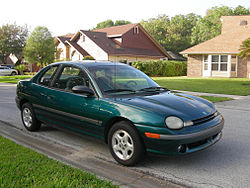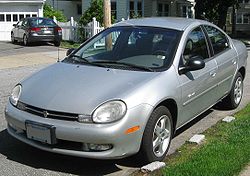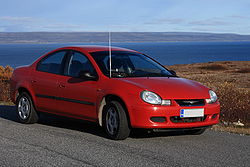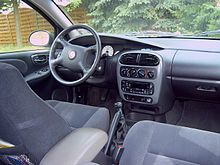- Chrysler Neon
-
Chrysler Neon/Dodge Neon/Plymouth Neon Manufacturer Chrysler LLC (1995–1998) DaimlerChrysler (1998–2005) Also called Dodge Neon
Chrysler Neon (Europe)
Dodge SX 2.0 (Canada)Production 1995–2005 Assembly Belvidere, Illinois, United States
Toluca, Mexico
Valencia, VenezuelaPredecessor Dodge Colt
Dodge Shadow
Plymouth Sundance/Duster
Plymouth LaserSuccessor Dodge Caliber Class Compact car Layout FF layout Platform Chrysler PL platform Related Dodge SRT-4 The Plymouth/Dodge Neon, sold in Europe, Mexico, Canada, and elsewhere outside the United States as the Chrysler Neon, is a compact front wheel drive car introduced in January 1994 for the 1995 model year by Chrysler Corporation's Dodge and Plymouth brands. It was branded as a Chrysler model in Japan, Europe, and Australia (where it was the first car to be sold as a Chrysler since 1981) export markets, as well as in Mexico, Canada, and Egypt. It replaced the Dodge Shadow and Plymouth Sundance & Duster models and the Dodge & Plymouth Colt. The two-door model also replaced the Plymouth Laser in Plymouth's lineup. The Neon was offered in multiple versions and configurations over its production life, which ended on September 23, 2005.
Contents
1995–1999
First generation 
Also called Chrysler Neon
Dodge NeonProduction 1995–1999 Body style 2-door coupe
4-door sedanEngine 2.0 L A588 I4
2.0 L ECC I4Transmission 5-speed NVG T-350 manual
3-speed 31TH automaticWheelbase 104.0 in (2,640 mm) Length 171.8 in (4,360 mm) Width 67.5 in (1,710 mm) Height 54.9 in (1,390 mm) The first generation Neon was introduced in January 1994 and manufactured until August 1999. It was available as a four-door sedan and a two-door coupe. Available engines were SOHC and DOHC versions of Chrysler's 2.0 L 4-cylinder engine producing 132 hp (98 kW) at 6000 rpm and 129 lb·ft (175 N·m) at 5000 rpm or 150 hp (110 kW) at 6500 rpm and 133 lb·ft (180 N·m) at 5600 rpm, respectively; transaxle options were a 3-speed Torqueflite automatic or a five-speed manual.
The car was badged and sold as both a Dodge and a Plymouth in the United States and Canada; in Mexico, Europe, Australia and other export markets it was sold as the Chrysler Neon. At the Neon's release, then president of Chrysler Corporation Bob Lutz said, "There's an old saying in Detroit: 'Good, fast, or cheap. Pick any two.' We refuse to accept that."[citation needed] The Japanese press touted the Neon as the "Japanese car killer", due to a spiralling Yen and the lower production cost of the Neon.[citation needed] The Neon received praise for its appearance, price, and power when compared to competing cars such as the Honda Civic DX at 102 hp (76 kW), the Civic EX at 125 hp (93 kW), the Nissan Sentra at 115 hp (86 kW), the Ford Escort ZX2 at 130 hp (97 kW), the Toyota Corolla at 115 hp (86 kW), and the Chevrolet Cavalier Base and LS models at 120 hp (89 kW), among others. Car and Driver tested the DOHC 5-speed equipped Neon R/T and reported that it could run 0-60 in 7.6 seconds and 15.9 seconds in the quarter mile.[citation needed] First-generation Neons were competitive in SCCA Solo autocross and showroom-stock road racing.[1]
Equipment
Neons had unconventional option availability, including the lack of power windows in the rear doors. Certain color base-model Neons, including red and black, had bumper covers molded in color rather than painted. These covers, while textured and not as glossy as paint, absorbed scuffs and scrapes with less visible damage. The mid-level Highline models in 95 & 96 used wheel covers with a bubble design. Initially, Neons were available in many bold colors including Nitro yellow-green, Lapis Blue, Aqua, and Magenta, however paint color choices became more subdued by the 1998-1999 model years, as the majority of buyers opted for more traditional colors.
The Australian-market Chrysler Neon came in two models, the SE and the better-equipped LX. Later, the LX model was replaced by the LE with the updated model in 1999. In the United States, the lineup started out as Base, Highline, and Sport, with different styles and options in each line, but the lineup titles changed frequently (other trim lines included Expresso, SE, ES, SXT, ACR, and R/T). In Europe, the car was available with a 1.8 L engine. Europe received one limited edition model, the CS, which came only in Platinum paint. It was fitted with the 131 bhp (98 kW) SOHC engine, American R/T specification suspension (slightly lower, 3.5 cm (1.4 in) rear, 2.7 cm (1.1 in) front), rear spoiler, unique alloy wheels, standard leather interior, double stainless steel exhaust, 6CD charger and a shorter 5-speed manual gearbox.
Trim levels
Plymouth Neon: 1995–1999
- base - 1995
- Highline - 1995–1999
- Sport - 1995–1996
- Expresso - 1996–1999
- EX - 1998–1999
- ACR - 1995–1999
- Style - 1998–1999
Dodge Neon: 1995–1999
- base - 1995
- Highline - 1995–1999
- Sport - 1995–1999
- EX- 1998–1999
- ACR - 1995–1999
- R/T - 1998–1999
Chrysler Neon (Europe): 1995–1999
- LE - 1995–1999
- LX - 1995–1999
- SLX - 1997
- GLX - 1997–1999
- CS - 1998
Special models
ACR
The ACR Neon, available with either the SOHC or DOHC engine, featured four-wheel disc brakes, Arvin non-adjustable struts for 1995–1996 models and Koni adjustable dampers for 1997–1999 models, thicker anti-sway bars, fast-ratio steering, heavy-duty front wheel hubs, and a five-speed manual transmission with a numerically higher .81 fifth gear and final drive ratio of 3.94 for quicker acceleration. 1995 through 1997 models featured adjustable camber. The computer-controlled speed limiter was removed from 1995 ACR models (limited to 135 mph (217 km/h) on later models), and ABS was also, to save weight. The ACR offers no badging to distinguish it from other Neon models; the only visible differences are a bumper with fog light holes, but no fog lights and a lack of side moldings. In 1995, the ACR was only offered to SCCA members, but in subsequent years it was available to the general public. The name "ACR" was initially the internal ordering code for the "Competition Package", as it was termed in dealer materials; however, as knowledge of the model spread, the ACR name stuck. The backronym "American Club Racer" was coined due to its popularity with club and grassroots racers.
R/T
The R/T model (Road/Track) debuted in the 1998 model year. Offered only with a 5-speed DOHC configuration, the R/T featured many of the ACR's mechanical upgrades including the numerically higher ratio 3.94 5-speed manual transmission, with the .81 5th gear and 135 mph speed limit. The R/T, however, was intended for the street, with more comfort and convenience features standard or available, and specialized parts like the adjustable dampers removed, although the dampers as well as the front coil springs found on R/T models were slightly stiffer, offering an advantage over standard model Neons. R/Ts featured optional stripes over the top of the car, silver "R/T" badging on the front door panels and the right side of the trunk deck lid, and a functional wing. The "Stripe Delete" option was available from the factory, but with no credit to the Neon's price. All striped R/Ts (black, red, blue) had silver colored stripes, with the exception of the White R/Ts, which came with dark blue colored stripes.
2000–2005
Second generation 
Also called Chrysler Neon
Dodge Neon
Dodge SX 2.0Production 2000–2005 Body style 4-door sedan Engine 2.0 L SOHC A588 I4 Transmission 5-speed NVG T-350 manual
3-speed 31TH automatic
4-speed 41TE automaticWheelbase 105.0 in (2,670 mm) Length 174.4 in (4,430 mm) Width 67.4 in (1,710 mm) Height 56.0 in (1,420 mm) Related Dodge SRT-4 Sales of the second generation model started with model year 2000 and production ended with the 2005 model year. The second generation Neon was only available as a four-door sedan. In some global sales regions, including the U.S., the sole engine was the 2.0 L SOHC engine, the power output remaining at 132 hp (98 kW). An optional Magnum engine configuration (with an active intake manifold) that produced 150 hp (110 kW) was available. Both engines had a redline of 6762 rpm.
The second generation was more refined than the first generation car. It was advertised that the second generation Neon had over 1,000 refinements from the original generation. The first generation's frameless windows were replaced with a full-framed door. Other NVH refinements were implemented. The new interior and greater size increased weight. The DOHC ECC engine was no longer available.
In 2001, The R/T trim returned after a one-year hiatus. The R/T consisted of a new 150 hp (110 kW) SOHC Magnum 2.0 L Engine, 16 in (41 cm) wheels, spoiler, dual chrome exhaust tips, quicker steering box and stiffer springs. The 2001 and 2002 R/Ts had a flat, 'hammerhead' spoiler. From 2000-2003, the R/T was sold as a Chrysler in Europe. The Neon was offered with a Sport package for the 2001 model year only. It consisted of an R/T wing, R/T 16 in (41 cm) wheels, R/T springs, white instrument cluster and R/T steering box. It was an R/T visually except for the lack of dual exhaust, R/T lower mouldings, fog lamps and R/T exclusive front bumper. The Sport only came equipped with the base model's 132 hp (98 kW) engine and was available with an automatic transmission (unlike the manual-only R/T model). 2001 was the last year for the Plymouth Neon, and the Plymouth brand as well, the last Plymouth Neon (which also was the last Plymouth), a silver four-door sedan, rolled off the assembly line on June 28, 2001.
The former Dodge and Plymouth Neon were briefly sold under the Chrysler name in Canada from 2000–2002, until being renamed as Dodge SX 2.0 for 2003. In Europe, Australia, Mexico, and Asia, the car had always been sold as a Chrysler, as Dodge and Plymouth passenger cars were not marketed outside the U.S. and Canada at the time. Besides the 2.0 L engine, it used the same Tritec 1.6 L unit found in the MINI prior to 2007. The 1.6 L unit is a variation of the 2.0 L SOHC engine designed by Chrysler and built by Tritec.[2]
Originally, the second generation Neon featured a five-speed manual transmission using the former ACR gear ratios to improve acceleration. However, this hurt gas mileage and made the car noisier on the highway, and eventually the original gear ratios were restored. A four-speed automatic (41TE) was offered in the Neon for the 2001-05 model years, replacing the earlier 3-speed 31TH.
The Neon's name was changed to SX 2.0 in Canada in 2003. In Australia and Canada, the Chrysler Neon was discontinued in 2002. In 2002, the front clip was changed to match the R/T and ACR front clip with the exception of missing a lower lip. The Neon was facelifted again for 2003 with large "crosseyed" headlights and crosshair grille. The ACR model was discontinued for 2003; the R/T model for 2004. The Chrysler Neon continued to be sold in Europe until 2004.
In Brazil, the Neon was marketed as a luxury mid-size sedan; for Mexico it was a competitor to the Ford Escort, and sold as a Chrysler with either the 1.6 or 2.0 L engine and European-style taillights (with separate amber indicator lights), except for the R/T model, which was a Dodge, with U.S.-style taillights.
For the Dutch market, the Neon proved more successful than the rest of the Continent. Trim levels were 2.0 LX and 2.0 SE. However, some grey import versions came in from Mexico.
Trim levels
Dodge Neon: 2000–2005
- Highline - 2000–2001
- ES - 2000–2002
- SE - 2001–2005
- R/T - 2001–2004
- base - 2002
- S - 2002
- SST - 2002
- SXT - 2002–2005
- SRT-4 - 2003-2005
Plymouth Neon: 2000–2001
- Highline - 2000–2001
- LX - 2000–2001
Chrysler Neon: 2000–2004 (Europe)
- R/T - 2000–2003
- LX - 2000–2004
- SE - 2000–2003
Chrysler Neon: 2000–2004 (Canada)
- LE - 2001 Limited Edition
- SE - 2000–2004
Final year
DaimlerChrysler discontinued the Neon, with the final cars assembled on September 23, 2005 at the Belvidere Assembly plant in Belvidere, Illinois.[3] The Neon was replaced in the spring of 2006 with the 2007 Dodge Caliber, which is based on the shared Chrysler/Mitsubishi Motors GS platform. Like the Neon, the Caliber had an SRT-4 variant, but like the standard Caliber, it used a completely different engine.[2] The Belvidere plant underwent retooling for the Caliber, Jeep Compass and Patriot.
In markets like Australia the Neon range was reduced to either 2.0 LX or 2.0 SE models.
Safety
The first generation Neon earned a "Poor" rating in an offset frontal Crash test conducted by the Insurance Institute for Highway Safety . The second generation Neon earned a higher "Marginal" rating. The second generation were rated as "Poor" in the side impact crash test[4] (IIHS Safety ratings go from "Poor", to "Marginal", "Acceptable" and "Good"). Only the Chevrolet Cavalier performed worse in the small car category in 2005, the Neon's final year.[5] Other cars made from 2000 to 2005 which were rated "Poor" when tested without optional side airbags included the Ford Focus, Toyota Corolla, Toyota Prius, Mitsubishi Lancer, and Chevrolet Cobalt. No small car made in this period, tested without side airbags, achieved better than a "Poor."[6]
In 2005, the Institute carried out side impact tests on 14 small car models, simulating an impact with an SUV. Among these, the Neon performed the worst. IIHS stated that the Neon had “...major problems beginning with its structure. This car is a disaster...The structure is poor...If this had been a real driver in a real crash, it’s likely it wouldn’t have been survivable...if safety is a priority, the Neon is a small car to be avoided.”[7]
Second generation headrests were rated as "Poor".[8]
Driver deaths fatality risks statistics — published by the IIHS — rated the Neon and 15 other vehicles among the "Highest rates of driver deaths.", The Neon had 161 driver deaths per million registered vehicle deaths, while the average for the Neon class (4-door small) was 103. Other small cars on the list included the Acura RSX (202), Kia Spectra hatchback (191), and the Mitsubishi Eclipse (169).[9]
References
- ^ "Farewell road test: 2005 Dodge SRT4 Editor's Review | Page 1". Auto123.com. http://www.auto123.com/en/info/news/ourwriters,view,.spy?artid=52904&pg=1&author=4. Retrieved 2009-08-01.
- ^ a b "The Chrysler/Mini (Rover) 1.4 and 1.6 Engines". Allpar.com. http://www.allpar.com/mopar/rover.html. Retrieved 2010-10-29.
- ^ [1][dead link]
- ^ "IIHS-HLDI: Dodge Neon". Iihs.org. http://www.iihs.org/ratings/ratingsbyseries.aspx?id=382. Retrieved 2009-08-01.
- ^ "IIHS News: March 6, 2005" (PDF). http://www.iihs.org/news/2005/iihs_news_030605.pdf. Retrieved 2009-08-01.
- ^ Insurance Institute for Highway Safety Report
- ^ Insurance Institute for Highway Safety report
- ^ "Head restraints: Dodge". Iihs.org. http://www.iihs.org/ratings/head_restraints/headrestraints.aspx?dodge. Retrieved 2009-08-01.
- ^ Driver´s deaths by make&model: Fatality risk in one vehicle versus another
External links
- Chrysler.com - 2001 Plymouth Neon, courtesy of Internet Archive
- Allpar.com - Neon section of Allpar
« previous — Dodge road car timeline, United States market, 1980s–present Type 1980s 1990s 2000s 2010s 0 1 2 3 4 5 6 7 8 9 0 1 2 3 4 5 6 7 8 9 0 1 2 3 4 5 6 7 8 9 0 1 2 Subcompact Omni Colt Colt Colt Colt Omni 024 Charger Compact Colt 400 Shadow Neon Neon Caliber Aspen Aries Mid-size Lancer Mirada 600 Spirit Avenger Diplomat Dynasty Stratus Stratus Full-size St. Regis Monaco Intrepid Intrepid Magnum Charger Charger Sport compact Daytona Avenger SRT-4 Sports Challenger Conquest Stealth Challenger Viper Viper Viper Viper « previous — Plymouth road car timeline, 1970s–2001, United States market Type 1970s 1980s 1990s 2000s 0 1 2 3 4 5 6 7 8 9 0 1 2 3 4 5 6 7 8 9 0 1 2 3 4 5 6 7 8 9 0 1 Subcompact Cricket Horizon TC3 Turismo Colt Colt Colt Colt Compact Arrow Sundance Neon Neon Colt Colt Colt Valiant Volaré Reliant Mid-size Caravelle Acclaim Breeze Satellite Fury Gran Fury Full-size Fury Gran Fury Gran Fury Sports Duster Sapporo Laser Road Runner Road Runner Road Runner Conquest Barracuda Prowler Prowler GTX SUV Trailduster Pickup Arrow Truck Scamp Minivan Voyager/Grand Voyager Voyager/Grand Voyager Voyager/Grand Voyager Van Voyager Dodge Current
productionCarsTrucks (Ram)Discontinued Cars024 · 330 · 400 · 600 · 880 · Aries · Aspen · Avenger · Brisa · Challenger · Charger (B-body) · Charger (L-body) · Charger Daytona · Colt · Conquest · Coronet · Custom 880 · Dart · Daytona · Demon · Diplomat · Dynasty · Intrepid · La Femme · Lancer · Matador · Mirada · Monaco · Neon · Omni · Phoenix · Polara · SE · Shadow · Sierra · Spirit · SRT-4 · St. Regis · Stealth · Stratus · Super BeeTrucks50 Series · 100 Series · 500 Series · A100 · B Series · C Series · D Series · Power Wagon · Rampage · Ram 50 · VC series · VF series · WC seriesCorporate Historic CarsAcclaim • Arrow • Barracuda • Belvedere • Breeze • Cambridge • Caravelle • Champ • Colt • Concord • Conquest • Cranbrook • Cricket (North America, Canada) • Deluxe • Duster • Fury • Gran Fury • GTX • Horizon • Laser • Neon • Plaza • Prowler • Reliant • Road Runner • Sapporo • Satellite • Savoy • Special Deluxe • Sundance • Superbird • TC3 • Turismo • Valiant • VIP • VolaréConcept CarsTC 2000 Championship Seasons Current cars (2011) Chevrolet Cruze • Fiat Bravo • Honda Civic Si • Toyota Corolla • Renault Fluence • Volkswagen Golf • Volkswagen Polo • Ford Focus • Peugeot 307Current circuits Córdoba • General Roca • Oberá • Jorge Ángel Pena • Río Hondo • Resistencia • Santa Fe • Buenos Aires • Centenario • Punta del Este (Uruguay) • Eduardo Copello • San LuisFormer circuits Bahía Blanca • Comodoro Rivadavia • Güemes • Curitiba (Brazil) • Interlagos (Brazil) • Paraná • ViedmaCategories:- Chrysler vehicles
- Front wheel drive vehicles
- Compact cars
- Coupes
- Sedans
- 1990s automobiles
- 2000s automobiles
- Vehicles introduced in 1994
- Motor vehicles manufactured in the United States
Wikimedia Foundation. 2010.




